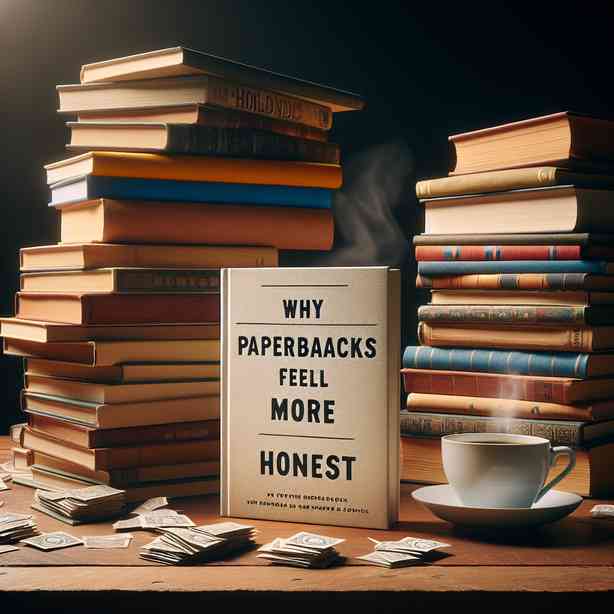
In the realm of literature, the physical format of a book can significantly influence a reader’s experience and perception. Among various formats, paperbacks hold a unique and special place, evoking a sense of authenticity and warmth that transcends mere words. This sentiment is especially important in today’s digital age, where e-books and audiobooks dominate the literary landscape. Understanding why paperbacks feel more honest requires delving into several interconnected aspects, including the tactile experience, the aesthetic appeal, the nostalgia associated with printed books, and their accessibility.
To begin with, the tactile experience of holding a paperback creates a connection between the reader and the book that digital formats often lack. The weight of the book in one’s hands, the texture of the cover, and the feel of the pages as they are turned all contribute to a sensorial experience that is deeply rooted in human interaction. For many readers, this physicality is synonymous with comfort and intimacy. As one turns the pages, there’s an inherent pleasure in the movement, an act that engages both the mind and the body. This sensory involvement fosters a stronger connection to the narrative, making the experience feel more genuine compared to the more detached engagement offered by digital formats.
Aesthetically, paperbacks often embody a certain charm that appeals to readers on a personal level. The cover art, the typography, and even the design layout play significant roles in attracting readers. Each paperback carries with it the identity of its content, allowing readers to choose books not just for the stories within but also for their visual appeal. This selection process often feels like a personal expression of taste and preference, organically building a connection to the book itself. Moreover, the sight of a well-stocked bookshelf filled with colorful paperbacks can evoke a sense of wonder and excitement, creating a physical representation of a reader’s journey through various narratives.
Nostalgia is another powerful element contributing to the perception of honesty associated with paperbacks. For many, reading a physical book is a cherished memory tied to childhood or significant life moments. The smell of the pages, the sound of paper crinkling, and the ritual of flipping through pages evoke emotions that digital readers simply cannot replicate. This nostalgia often conjures images of simpler times, perhaps spent curled up in a cozy corner with a favorite book, free from the distractions of the modern world. Such associations create a lasting bond between the reader and the physical book, reinforcing the idea that paperbacks represent not just stories but cherished memories.
Additionally, the accessibility of paperbacks enhances their appeal. Unlike e-readers that require charging, paperbacks can be enjoyed anywhere without the need for technology or a power source. This timeless quality allows readers to engage with literature in various settings—from a park to a quiet café—without the interruptions that electronic devices often bring. The simplicity of picking up a paperback and diving into a story creates an atmosphere of relaxation and escapism, fostering a relationship with the book that feels more honest and sincere.
Furthermore, the economic aspect of paperbacks adds another layer to their perceived authenticity. Generally, paperbacks are more affordable than their hardcover counterparts and digital formats. This affordability encourages readers to explore a wider range of authors and genres without the risk of financial investment. In this way, paperbacks democratize literature, allowing more people to access stories and ideas that resonate with them. The idea that anyone can pick up a paperback and find joy, inspiration, or profound insights contributes to the perception of paperbacks as honest, approachable vessels of knowledge and creativity.
Moreover, the communal aspects of reading paperbacks enhance their authenticity. Sharing a physical book with friends or family, discussing its themes, or even lending it to someone else connects readers in a way that digital sharing often lacks. The act of passing a book from one person to another—complete with personal notes, highlights, and even the wear and tear of repeated use—transforms the paperback into a shared experience that transcends individual ownership. This communal narrative fosters a deeper appreciation for the stories being told and emphasizes the interconnectedness of readers.
As we reflect on the role of paperbacks in our literary lives, it’s essential to acknowledge the profound impact that these simple yet extraordinary books have on our experiences. The combination of tactile pleasure, aesthetic appeal, nostalgia, accessibility, affordability, and communal sharing all contribute to the perception that paperbacks are genuine and honest mediums of storytelling. They invite readers into a world where stories can be savored, discussed, and shared, creating lasting memories that echo long after the final page has been turned.
In conclusion, while technology continues to evolve and shape the way we consume literature, the enduring charm of paperbacks remains irreplaceable. They embody an honesty that resonates with readers of all ages and backgrounds. In a world where connections can sometimes feel fleeting or insincere, reading a paperback offers a grounding experience that reminds us of the power of stories and shared experiences. This sense of authenticity, intertwined with our deepest feelings and memories, ensures that paperbacks will always hold a special place in our hearts and literary traditions. Ultimately, the honesty felt through the pages of a paperback transcends mere words; it reflects our collective human experience, allowing us to connect with both the stories and one another in the most profound ways.


